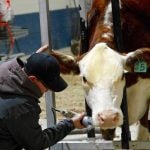Good foundation stock kept in healthy condition make it easier to be profitable in the goat industry, says Dr. Kathy Parker, a veterinarian from Three Hills.
Speaking to the Alberta Goat Association here last month, Parker emphasized the importance of keeping animals as healthy as possible to avoid the cost of medication and vet bills. She also stressed good record-keeping, keeping track of stock with ear tags and weighing kids at birth and every month after.
Culling goats with basic problems can go a long way towards improvement of the herd, Parker said. She culls goats with “parrot mouths” — beak-like mouths that make it difficult for them to graze.
Read Also

Canada’s slaughter horse industry lacks transparency
Horse slaughter is a fraught issue right now in the Canadian livestock sphere. The author writes that, while it has a role, traceability, transparency and humane handling must be in play.
Jaws take a long time to grow, so producers should watch for parrot mouth until the animals are mature, Parker said.
“If you select replacement animals at weaning, you’d better be looking for this when they are 18 months old. They may be good when they are babies, but they’re not so good when they’re two (years),” she said.
“Milk mouth,” also known as bulldog mouth, means the animal has a severe underbite. The heritability of these traits is not well documented.
“We tend to cull these because we just don’t know,” she said. She advises culling the offspring of any animal with a parrot or milk mouth.
Udder selection
Parker also emphasized the importance of good udders, as this has a direct influence on the viability of kids, who need to be able to suckle easily and effectively.
“Udder selection needs to be a deliberate act. You look at those udders when she’s fresh,” said Parker.
Sire lines contribute to effective udders. If possible, producers should try to look at the mother of a buck to check her udder as well.
“The good thing about udder selection is that when you select for good teats, good udder suspension or width you get the whole package,” Parker said. “It’s not possible to only select for teat confirmation and not get good suspension as well.”
Conformation is also important. Goats need good legs in order to support their frames. They should have good, straight legs and should not be bowlegged, pigeon toed or offset.
“Sore, small ruminants don’t produce,” said Parker. “They may get pregnant, but they’ll never produce or develop as well as they should when they are hurting all the time.”
Parker said that sires influence the health of their daughters. Bucks with small testicles can result in daughters with fewer eggs and smaller litters.















